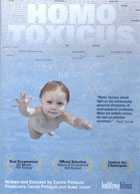
Homo Toxicus 2008
Distributed by Bullfrog Films, PO Box 149, Oley, PA 19547; 800-543-FROG (3764)
Produced by Les Productions ISCA, Carole Poliquin and Isaac Isitan
Directed by Carole Poliquin
DVD, color, 88 min. and 52 min. versions
College - Adult
Health Sciences, Environmental Studies
Date Entered: 11/03/2009
Reviewed by Lori Widzinski, Health Sciences Library, University at Buffalo, State University of New YorkHungry? How about some salmon with PCBs? Or some tuna with mercury with a side of nonylphenol garlic butter and pesticide fruit for dessert? It’s hard to avoid those pesky environmental chemicals that are now part of almost everything we eat, drink, and breathe. Homo Toxicus takes a look at the impact that man-made environmental chemicals are having on our species.
The filmmaker of this Canadian production, Carole Poliquin, has her own blood analyzed for environmental chemicals. When she discovers over one hundred different compounds (even DDT) she embarks on a journey to discover the connection between our modern, convenient lifestyle, our environment and our health. Through interviews with researchers, academics, government officials, scientists, pharmaceutical industry representatives and residents of two heavily polluted areas, a complicated and somewhat dire picture emerges.
The amounts of chemicals that the Canadian governments allows in consumable goods is very small…but scientists have proven that even small amounts of certain chemicals, or the mixture of small amounts may build up and cause severe public health problems. Poliquin visits two different Canadian regions where environmental chemicals are changing the population. One, a tiny Nunavut village where the people have the world’s highest concentrations of PCBs and mercury in their bodies. Here the children are experiencing a weakened immune system towards ear infections, causing a significantly high percentage of deteriorating eardrums and hearing loss. The other is a reservation for native peoples in Sarnia, Ontario, often called “Chemical Valley” because of the proximity to oil refineries and chemical waste dumps. Public health officials are seeing alarming declines male birth rates, among other health problems. (See EMRO’s review of The Beloved Community for another film about Sarnia.) While these two areas may be extreme, they are alarm signals. Poliquin also looks at the effects of pesticides and fungicides in our fruits and vegetables as well as hormones in the meat we consume.
There’s no shortage of films on this topic, and Homo Toxicus is a worthy addition to the group. It takes an “everyman’s” viewpoint and includes a variety of statistics and research findings. It is filmed in French with English narration and subtitles are available. Both 88 minute and 52 minutes versions are included on the DVD, as well as a set of extras comprised of many of the researchers and scientists in the films speaking further on their particular areas of expertise. The technical components are well done, with especially striking and beautiful Nunavut throat singing accompanying the Nunavut section. Recommended for academic libraries with collections in public health, environmental health and environmental studies in general.